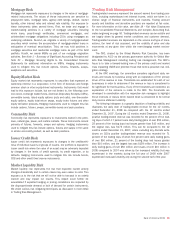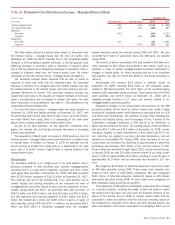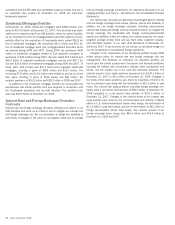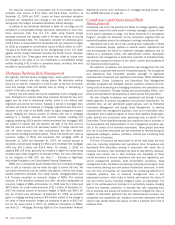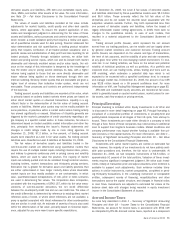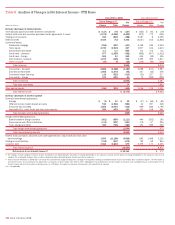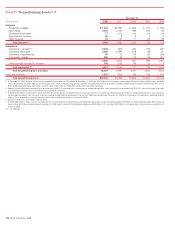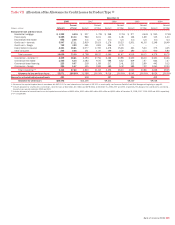Bank of America 2008 Annual Report Download - page 97
Download and view the complete annual report
Please find page 97 of the 2008 Bank of America annual report below. You can navigate through the pages in the report by either clicking on the pages listed below, or by using the keyword search tool below to find specific information within the annual report.derivative assets and liabilities, AFS debt and marketable equity secu-
rities, MSRs, and certain other assets at fair value. For more information,
see Note 19 – Fair Value Disclosures to the Consolidated Financial
Statements.
The values of assets and liabilities recorded at fair value include
adjustments for market liquidity, credit quality and other deal specific
factors, where appropriate. To ensure the prudent application of esti-
mates and management judgment in determining the fair value of these
assets and liabilities, various processes and controls have been adopted,
which include: a model validation policy that requires a review and appro-
val of quantitative models used for deal pricing, financial statement fair
value determination and risk quantification; a trading product valuation
policy that requires verification of all traded product valuations; and a
periodic review and substantiation of daily profit and loss reporting for all
traded products. Primarily through validation controls, we utilize both
broker and pricing service inputs, which can and do include both market
observable and internally modeled values and/or value inputs. Our reli-
ance on the receipt of this information is tempered by the knowledge of
how the broker and/or pricing service develops its data, with a higher
reliance being applied to those that are more directly observable and
lesser reliance being applied on those developed through their own
internal modeling. Similarly, broker quotes that are executable are given a
higher level of reliance than indicative broker quotes, which are not
executable. These processes and controls are performed independently
of the business.
Trading account assets and liabilities are recorded at fair value, which
is primarily based on actively traded markets where prices are based on
either direct market quotes or observed transactions. Liquidity is a sig-
nificant factor in the determination of the fair value of trading account
assets or liabilities. Market price quotes may not be readily available for
some positions, or positions within a market sector where trading activity
has slowed significantly or ceased. Situations of illiquidity generally are
triggered by the market’s perception of credit uncertainty regarding a sin-
gle company or a specific market sector. In these instances, fair value is
determined based on limited available market information and other fac-
tors, principally from reviewing the issuer’s financial statements and
changes in credit ratings made by one or more rating agencies. At
December 31, 2008, $7.3 billion, or five percent, of trading account
assets were classified as Level 3 fair value assets. No trading account
liabilities were classified as Level 3 liabilities at December 31, 2008.
The fair values of derivative assets and liabilities traded in the
over-the-counter market are determined using quantitative models that
require the use of multiple market inputs including interest rates, prices,
and indices to generate continuous yield or pricing curves and volatility
factors, which are used to value the position. The majority of market
inputs are actively quoted and can be validated through external sources,
including brokers, market transactions and third-party pricing services.
Estimation risk is greater for derivative asset and liability positions that
are either option-based or have longer maturity dates where observable
market inputs are less readily available or are unobservable, in which
case, quantitative-based extrapolations of rate, price or index scenarios
are used in determining fair values. The Corporation does incorporate,
consistent with the requirements of SFAS 157, within its fair value meas-
urements of over-the-counter derivatives the net credit differential
between the counterparty credit risk and our own credit risk. The value of
the credit differential is determined by reference to existing direct market
reference costs of credit, or where direct references are not available, a
proxy is applied consistent with direct references for other counterparties
that are similar in credit risk. An estimate of severity of loss is also used
within the determination of fair value, primarily based on historical experi-
ence, adjusted for any more recent name specific expectations.
At December 31, 2008, the Level 3 fair values of derivative assets
and liabilities determined by these quantitative models were $8.3 billion
and $6.0 billion. These amounts reflect the full fair value of the
derivatives and do not isolate the discrete value associated with the
subjective valuation variable. Further, they both represented less than
one percent of derivative assets and liabilities, before the impact of
legally enforceable master netting agreements. In 2008, there were no
changes to the quantitative models, or uses of such models, that
resulted in a material adjustment to the Consolidated Statement of
Income.
Trading account profits (losses), which represent the net amount
earned from our trading positions, can be volatile and are largely driven
by general market conditions and customer demand. Trading account
profits (losses) are dependent on the volume and type of transactions,
the level of risk assumed, and the volatility of price and rate movements
at any given time within the ever-changing market environment. To eval-
uate risk in our trading activities, we focus on the actual and potential
volatility of individual positions as well as portfolios. At a portfolio and
corporate level, we use trading limits, stress testing and tools such as
VAR modeling, which estimates a potential daily loss which is not
expected to be exceeded with a specified confidence level, to measure
and manage market risk. At December 31, 2008, the amount of our VAR
was $138 million based on a 99 percent confidence level. For more
information on VAR, see Trading Risk Management beginning on page 85.
AFS debt and marketable equity securities are recorded at fair value,
which is generally based on quoted market prices, market prices for sim-
ilar assets, cash flow analysis or pricing services.
Principal Investing
Principal Investing is included within Equity Investments in All Other and
is discussed in more detail beginning on page 48. Principal Investing is
comprised of a diversified portfolio of investments in privately-held and
publicly-traded companies at all stages of their life cycle, from start-up to
buyout. These investments are made either directly in a company or held
through a fund. Some of these companies may need access to additional
cash to support their long-term business models. Market conditions and
company performance may impact whether funding is available from pri-
vate investors or the capital markets. For more information, see Note 1 –
Summary of Significant Accounting Principles and Note 19 – Fair Value
Disclosures to the Consolidated Financial Statements.
Investments with active market quotes are carried at estimated fair
value; however, the majority of our investments do not have publicly avail-
able price quotations and, therefore, the fair value is unobservable. At
December 31, 2008, we had nonpublic investments of $3.5 billion, or
approximately 91 percent of the total portfolio. Valuation of these invest-
ments requires significant management judgment. We value such invest-
ments initially at transaction price and adjust valuations when evidence is
available to support such adjustments. Such evidence includes trans-
actions in similar instruments, market comparables, completed or pend-
ing third-party transactions in the underlying investment or comparable
entities, subsequent rounds of financing, recapitalizations and other
transactions across the capital structure, and changes in financial ratios
or cash flows. Investments are adjusted to estimated fair values at the
balance sheet date with changes being recorded in equity investment
income in the Consolidated Statement of Income.
Accrued Income Taxes
As more fully described in Note 1 – Summary of Significant Accounting
Principles and Note 18 – Income Taxes to the Consolidated Financial
Statements, we account for income taxes in accordance with SFAS 109
as interpreted by FIN 48. Accrued income taxes, reported as a component
Bank of America 2008
95


